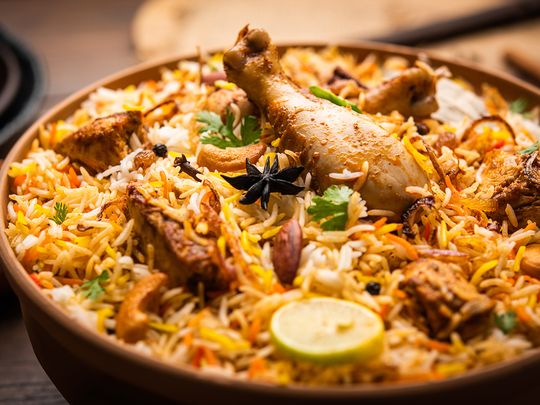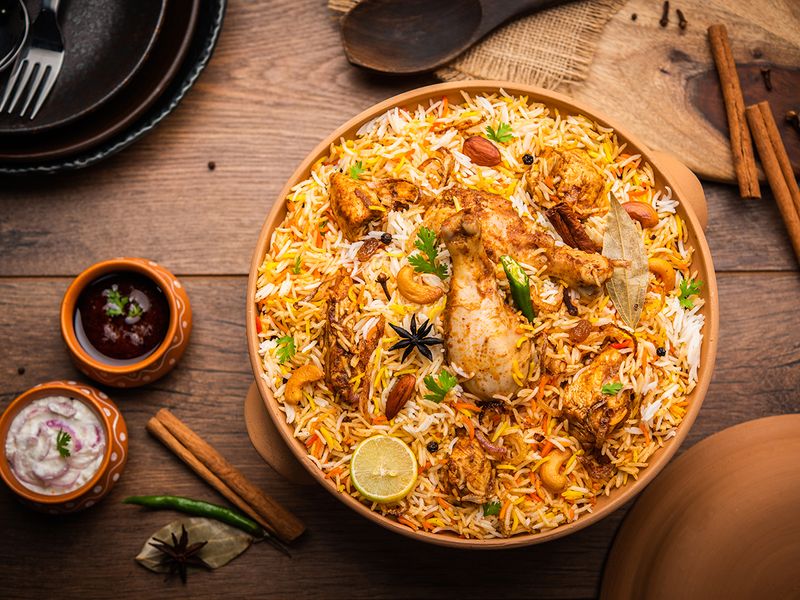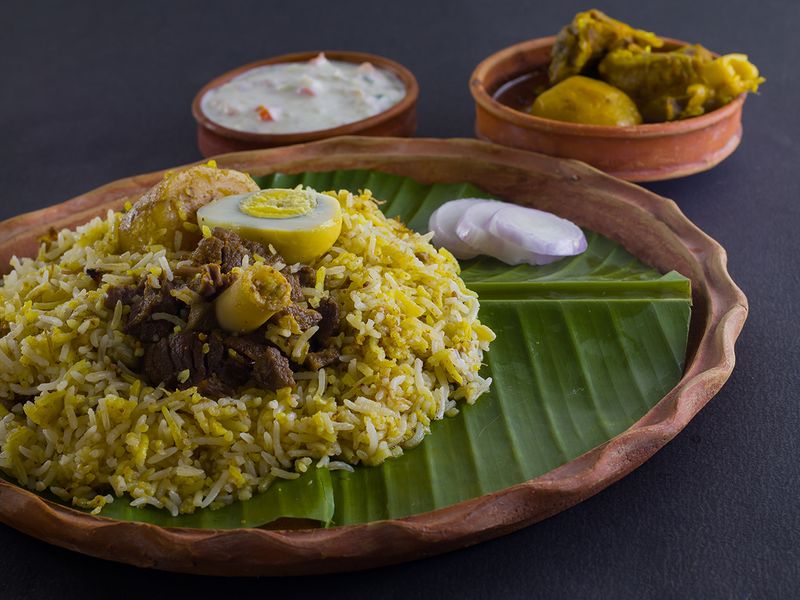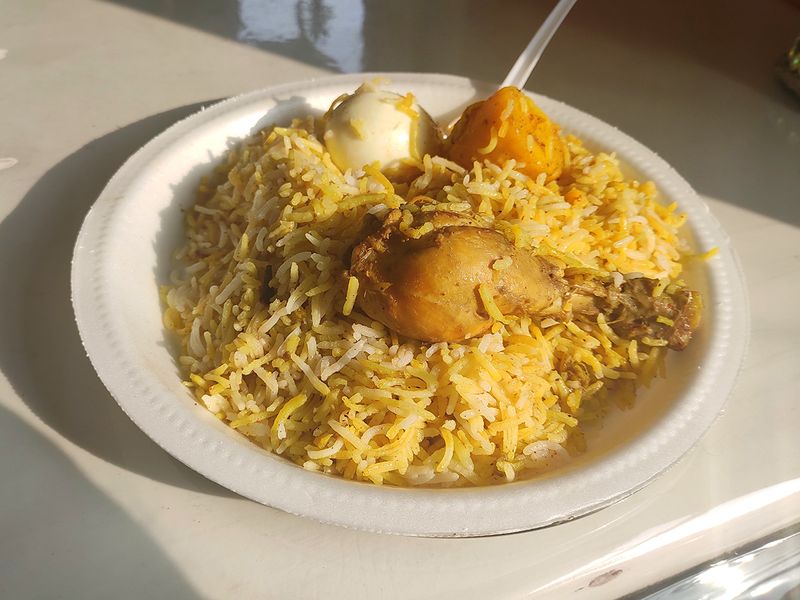
Biryani is more than food. It’s an emotion.
It’s the language of love. These tender, succulent pieces of meat, mixed with steaming, fluffy, long-grained rice, infused with saffron, nutmeg and cardamom, topped with browning curls of onion, a fried garnish of raisins and cashews, is steeped in meaning, memories and history. For people like Dubai-based budding chef Sartaj Singh, the fragrance of the spices remind him of his childhood: The days his mother would spend hours labouring in the kitchen, creating a masterpiece that would be relished for dinner.
It is also a cause for celebration, as he says. Weddings? Check. Birthdays? Check. A feast to commemorate the end of examinations? Double check. “Biryani is best shared with friends and family,” he chuckles. He recalls the inexplicably pleasant silence around the table, punctuated by just movement of bowls and spoons, as his friends and he would dig into the dish.
The ‘queen’ of the South Asian dishes, as it’s often dubbed, has flourished through time and history, evolving with new variations across India, Pakistan and Bangladesh.
The legend of biryani: Hazy, but delectable origins

A wartime staple? Or something crafted on a queen’s request?
What’s the story of biryani, I asked.
Sadaf Hussain, an Indian food historian and scholar, could barely keep the excitement out of his voice during our phone call as he started telling me the stories of biryani. Derived from the Iranian words, ‘berenj’ meaning ‘rice’ and ‘biryan’, which means fried before cooking, the dish is often believed to have been brought to the Indian subcontinent from Iran.
There are stories, and there are legends, he answered. We might not test the truth of many claims, but we relish them regardless, just like a plate of biryani. Of course, the exact origins are hazy. It has been believed that it was brought to the southern Malabar coast of India by Arab traders, who were frequent visitors to India. Hussain cites the existence of Oon Sooru: A rice dish mentioned in Tamil literature as early as 2 AD. Used to feed military warriors, this dish was made from rice, ghee, meat, turmeric, coriander, and pepper.

Another theory is that biryani has its roots in the nomadic and pastoral cultures of Central Asia, where Turkic people relied heavily on rice, meat, and dairy products for their livelihood. The dish would have been prepared with ingredients and local spices around a roaring fire. As such traders would have walked through the Silk Road, they would have introduced this culinary knowledge to the Indian Subcontinent.
Or could it be rooted in a war diet? Another legend is that the Turk-Mongol conqueror, Timur, brought biryani’s predecessor with him when he arrived at the frontiers of India in 1398 AD. Often considered a war campaign diet of his army, an earthen pot full of rice, spices and meats would be buried in a hot pot, before being dug out and served to the army.
However, something that mostly all historians do agree on: The Mughals were instrumental in bringing the biryani as we know it to us.
The Mughal flavouring: Food of the aristocracy and wealthy

The most common understanding is that the genesis of biryani took place in the royal kitchens of the Mughals, who ruled India from the 15th to the 18th centuries. As Hussain explains, legend has it that the Queen Mumtaz, the inspiration behind Agra’s Taj Mahal, was rather appalled after visiting the royal barracks. She was greeted by malnourished soldiers. And so, the queen instructed the royal kitchens to prepare a special dish, filled with rice and meat so that it would be a balanced meal for the troops. And, so, the result, was biryani.
The rice was fried in ghee. Meat, aromatic spices, and saffron were added to it before cooking the mixture over a wood fire. However, as US-based food historian Lizzie Collingham, the author of Curry, A Tale of Cooks and Conquerors, points out in her 2005 book, the essence of the dish had been stewing since the Mughal dynasty was established.

As the story goes, Queen Mumtaz visited the royal barracks and saw malnourished soldiers. And so, the queen instructed the royal kitchens to prepare a special dish, filled with rice and meat so that it would be a balanced meal for the troops. And, so, the result, was biryani....
Babur, the first Mughal King, who invaded India in 1526 was apparently disappointed with the food. As vegetarianism was the mainstay of northern India owing to the flourishing of Buddhism and Jainism, Babur missed his hearty meat-based dishes that he had earlier survived on, during his days of hiding out in the Samarkand Mountains, prior to the invasion of India. Those meat-based dishes had been crafted by shephards.
The Mughals hearty appetite for beef and mutton clashed with their new subjects. as Collingham writes. And so, in the Mughal kitchens, these “mismatched” culinary cultures, came together to produce a synthesis of the recipes and foods of northern Hindustan (as India was referred to at that time), central Asia, and Iran.
And Mughlai cuisine began to take form.
Babur’s son, Humayun, didn’t let the Mughlai taste fade. After a disparate and long exile of 15 years in Iran, he returned to India in 1555 AD, reclaimed his throne and brought back with him an army of Iranian cooks. These cooks brought with them the Iranian cooking secrets and crafts, that had been developed five centuries earlier. The piece-de-resistance of the Iranian cuisine? The rice-based pulao.
The shepherds prepared the pulaos over their campfires, which later transformed into a mouthwatering dish for the rulers. This pulao was fused with the melting pot of cultures that included Iran and Central Asia in India, slowly leading to the biryani as we know it today.
By Mughal Emperor Akbar’s reign (1556-1605 AD), the next ruler after Humayun, the pulao had melded well with spicy dishes in India, to create biryani. In this Iranian culinary technique, the meat was marinated in yoghurt. The onion, garlic, almonds and spices were added to the yoghurt to create a thick paste that coated the meat. After it was marinated, the meat was briefly fried, before being transferred to the pot. Similar to the cooking technique for pulao, the rice was heaped over the meat. The saffron, soaked in milk, was poured over the rice to give it colour and aroma. The dish was sealed, cooked slowly, with hot coals on the lid and around the bottom of the pot.
Food for the royals, and aristocracy, indeed, along with pulao. However, there has always been a bit of conflict regarding the difference between biryani and pulao.
The debate over pulao and biryani

In the 1860s, Abdul Halim Sharar, a British playwright tersely explained the difference between the two dishes, admittedly being rather dismissive towards biryani. “To the uninitiated, both are the same. But because of the amount of spices in biryani, there is always a strong taste of curried rice, whereas pulao can be prepared with such care that this can never happen,” he wrote, quoted by food researcher and historian Colleen Taylor Sen in her book, Feasts and Fasts: A History of Food In India. “In the view of gourmets, a biryani is a clumsy and ill-conceived meal with a really good pulao.”
Well, we would beg to differ. Hussain offers to explain the difference.
Both are long-grained rice dishes, prepared with either meat, poultry, fish, seafood or vegetables. It gets confusing. However, there are many regional and local variations and notable distinctions. “The pulaos are usually an accompaniment to a meal. Biryanis are the center,” he says. The pulao is a single-pot dish that is made by first sautéing the spices, meat and rice in oil, then adding a liquid and simmering until the liquid is absorbed.
Check out biryani recipes here:
For biryani, the meat and rice are prepared separately, then combined. The meat is marinated with yoghurt, spices, or ground onions, ginger and ginger pastes, spices, and then the rice is parboiled. After this, layers of meat and rice are put in the pot, which is sealed and slowly cooked for hours. “Usually, the spicing for pulao is simpler and milder, as compared to biryanis,” he says.
Regional, cultural variations of biryani
“I like the Kolkata biryani…,” I had once barely completed the sentence, when my friends interrupted instantly.
“What? But the Hyderabad one is so much better.”
“Don’t forget Lucknow, please.”
You see? Biryani is not just an emotion; it brings out a range of emotions in people, especially the variations of it. The beauty about biryani is that it’s not a uniform one-size dish, explains Sama Khan, a Dubai-based Indian chef. It has so many cultural variations, be it the way it’s prepared, or the additional touches imbued in it.

And the history of most of these variations, are deeply intertwined, as well. "The magic of biryani lies in its regional variations. The differences in biryani variations stem from factors like the choice of rice, meat, vegetables, spices, cooking methods, and accompanying ingredients like yogurt or saffron," explains Neeraj Rana,executive chef at the Bombay Bungalow, Dubai. "These elements contribute to distinct flavors, aromas, and textures," he says.

The magic of biryani lies in its regional variations. The differences in biryani variations stem from factors like the choice of rice, meat, vegetables, spices, cooking methods, and accompanying ingredients like yogurt or saffron...
As he explains, "Each state in India has its own unique culinary traditions, that influence the taste and preparation of biryani. Factors such as local ingredients, cooking techniques, and cultural preferences contribute to the distinctiveness of each state's biryani, making it a cherished part of regional cuisine," he says.
Kolkata biryani, a descendant of the Awadhi style: The introduction of the potato

The story of Kolkata’s biryani has a lot to do with an exiled Nawab.
Back in May 1856, a rather distraught Wajid Ali Shah came to Calcutta, today known as Kolkata. Over 500 families moved with him, out of respect. The British had confiscated his lands, treasury and banished him from Awadh, Lucknow, as Hussain explains. However, he was determined to bring the flourish of his Awadhi lifestyle, including architecture, music, poetry and of course food, to Calcutta.
Food historian, Pritha Sen, based in India, had earlier explained to Goya Blog, “One chef did not cook everything. Instead there were specialists — the chef cooked only biryani, a dessert chef made only desserts, often times making one particular kind of dessert alone, and then a different chef cooked only dals. He carried the Awadh kitchen set-up to Calcutta. It was lavish in a manner that Calcutta had never seen before.”
And slowly, Awadhi influences seeped into the city’s nobility. As this was a new culinary style for Calcutta, the rich Mughal spices were replaced by subtler, fragrant spices, says Khan. Awadhi cuisine focused on marination, and the dum pukht or steam style of cooking. “Awadhi biryani is much lighter and known for its subtle taste,” adds Khan. However, in Calcutta, the biryani took on a new life: It became spicier, and the potato was introduced into it as we know it today.
Why the potato? The story has it that when Shah came to Calcutta, he did not have enough money. So according to Sen, when the biryani became all the rage, he had to feed the people, who had moved for him. Since biryani was now the common man’s food, the potato was introduced to added to bulk up the dish by some chef in his kitchen. Wajid Ali Shah himself was possibly unaware that the potato had been introduced.
However, the potato was chosen for a specific reason. The potato had not entered the Calcutta market, owing to the British. It allowed Wajid Ali Shah and his nobility to maintain a sense of superiority despite reduced circumstances. The potato was exotic, it absorbed all the flavours, and added bulk without hampering the taste of the biryani, Sen explains.
Hyderabadi biryani
No discussion on biryani is complete without the mention of the Hyderabadi biryani. This came into being after the Mughals conquered Hyderabad and appointed a local governor, or Nizam, Asaf Jah. His chefs created almost 50 different styles of biryani that used goat meat, fish, quail, deer and even hare meat. And so, the dish became the favourite of the Nizams, who ruled over Hyderabad district through the 17th and 18th centuries.
Here, the partially cooked rice is layered with meat, dum pukht style. This layering technique allows the rice to absorb the fragrant essence of the meat, explains Khan, the food historian. The Hyderabadi biryani also has a far more intricate spice profile, which includes saffron, mint, and fried onions, adding complexity to the taste. Moreover, Hyderabadi biryani possesses the long-grain Basmati rice, which has a distinct aroma. It complements the texture of the dish, and that’s why you feel like the rice melts in your mouth.
The sweetness of the Dhaka biryani
In Dhaka, Bangladesh, there is a sweetness added to the biryani by Kewra or Screwpine water, a flower extract, explains Khan. Finally, it is garnished with fresh coriander leaves, mint leaves, and sliced green chilies. It’s a mix of rice, spices and meats, onions that are caramelised, and even has a dash of milk, which is what makes it so unique, explains Khan. For the sides, you can treat yourself to a yogurt-based dip and salad.













